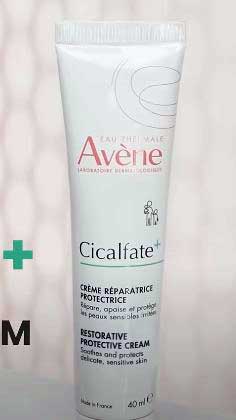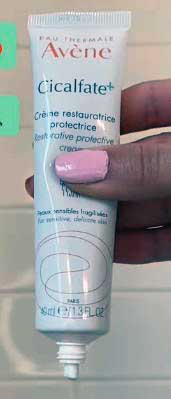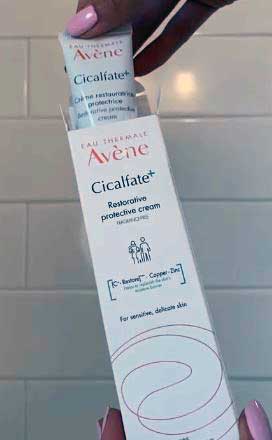If your skin’s screaming from irritation, dryness, or post-procedure redness, Avene Cicalfate Restorative Skin Cream is your answer.
It soothes and repairs with a gentle touch, becoming my go-to for calm, healthy skin.
Trust me, you’ll want this in your routine—grab it now and feel the difference.
My Experience With Avene Cicalfate Restorative Skin Cream

Last winter, my skin threw a tantrum—eczema patches on my cheeks and hands turned red, itchy, and downright miserable.
I’d cycled through countless lotions, but they either stung or did nothing.
Then, a friend raved about Avene Cicalfate after her laser treatment, so I gave it a shot.
The cream’s thick, ointment-like texture caught me off guard—it felt like it could tackle anything.
I applied a small dab to my irritated spots twice daily, post-cleansing with lukewarm water, and the relief was instant.
Within minutes, the stinging eased, and my tight skin relaxed, thanks to that thermal spring water magic.
By day three, my cheeks’ redness faded, and the flaky patches started peeling off naturally—no harsh scrubbing needed.
My cracked hands softened too; those painful fissures closed up, letting me use them without wincing. Unlike greasy balms, this didn’t pill under my SPF or makeup, so I layered it lightly in the mornings.
At night, I went heavier, waking up to smoother, less angry skin. A week in, my barrier felt stronger—no random tightness post-shower. I even used it on a shaving nick, and it healed fast, no scabby mess.
Two weeks later, my eczema was history. Now, I keep it for spot treatments—dryness, chapped lips, post-workout irritation, you name it. My sister, with rosacea, swears by it too. The small tube runs out quick if you’re generous, but the results are worth it.
Early on, I over-applied and felt greasy, but once I learned to use less, it was perfect. It’s my emergency skin-saver, always in my bag. If your skin’s sensitive like mine, this cream’s a game-changer, giving you that confident, calm glow you didn’t know you needed.
Also read: My Thoughts on Redness Defense Green Primer
Pros Of Avene Cicalfate Restorative Skin Cream

- Instant Relief: The thermal spring water soothes irritation on contact; my razor burn sting vanished in seconds, making it my go-to for quick calm.
- Fast Barrier Repair: Postbiotics rebuild your skin’s defenses, healing dry patches rapidly; my flaky cheeks smoothed out in days, no harsh actives needed.
- Family-Friendly: Safe for babies to adults, it tackles faces, bodies, even diaper rash; I used it on my kid’s chapped hands with zero issues.
- Non-Comedogenic: Despite its richness, it rarely clogs pores; my combo skin stayed clear, unlike heavier balms that sparked breakouts before.
- Antibacterial Boost: Copper-zinc fights bacteria, keeping cuts infection-free; a knee scrape healed cleanly, no lingering redness like with basic ointments.
- No Fragrance: Paraben- and scent-free, it’s gentle on sensitive skin; my rosacea-prone face stayed flare-free, a win over scented creams.
- Long-Lasting Moisture: It locks in hydration for hours, fighting dryness; winter winds couldn’t crack my hands with its protective layer.
- Post-Procedure Star: Perfect for laser or peel recovery, it cuts downtime; my friend’s microneedling redness faded fast with this.
- Scar Prevention: Promotes healthy healing, reducing marks; an acne scar I treated faded smoother, boosting my skin’s evenness.
- Makeup-Friendly: Layers under SPF or foundation without pilling; my morning routine stays seamless with a thin coat.
- Eco-Packaging: Recyclable, minimal tube aligns with clean beauty; I love that it’s effective without wasteful packaging.
- Confidence Builder: Regular use strengthens skin resilience; my routine feels less reactive, giving me glow-up vibes daily.
Cons Of Avene Cicalfate Restorative Skin Cream
- Heavy Texture: Over-apply, and it feels greasy, leaving a film; humid days made my face shiny until I used less.
- Breakout Risk: Mineral oil can clog for acne-prone skin; I got small bumps when using it all over, so I stick to spots.
- Small Tube: The 1.3-ounce size empties fast with daily use; my hands alone burn through it monthly, needing frequent repurchasing.
- Pricey Per Ounce: It’s costlier than drugstore balms; budget-conscious me hesitates, though the results soften the sting.
- Oily Skin Mismatch: Too occlusive for shiny skin; summer made me switch to lighter gels to avoid excess oil.
- Needs Careful Application: Rubbing too fast causes pilling; I learned to warm it between fingers for smooth blending.
- No Scent Option: Fragrance-free is safe but plain; I sometimes miss a luxurious aroma for a spa-like feel.
- Initial Flaking: Some see temporary worsening as skin sheds; my first week had peeling, which was annoying but cleared.
- Not Enough Alone: For very dry skin, it needs a lighter lotion layer; my arms craved more emollients than it offered solo.
- Stock Issues: Hard to find in stores, pushing me online; waiting for shipping during a flare-up was a hassle.
- Slight White Cast: Zinc can show on darker tones; I blend carefully to avoid residue under light makeup.
Maintenance Tips For Avene Cicalfate Restorative Skin Cream
- Clean, Damp Skin: Apply on slightly moist skin post-cleansing for better absorption; I mist with thermal water first for seamless blending.
- Thin Face Layers: Use a pea-size amount to avoid greasiness; patting lightly kept my skin calm without shine overload.
- Twice-Daily Routine: Morning under SPF, night for repair; this consistency cut my eczema flares to almost none.
- Gentle Cleanser Pairing: Use a mild, non-foaming wash to prep; Avene’s tolerance cleanser boosted my results, keeping irritation low.
- Cool Storage: Keep it from heat to preserve efficacy; bathroom humidity once altered mine, so I store it in a drawer.
- Spot Treatment Focus: Target problem areas to save product; I dab on cheeks, saving lighter creams for the rest.
- Avoid Actives Early: Skip retinoids initially to let it work; I added them slowly, letting Cicalfate strengthen my skin first.
- Gentle Massage: Use circular motions to spread evenly; this sped up hand crack healing compared to quick pats.
- Reapply Post-Wash: Refresh on hands after washing to fight dryness; this kept my cuticles soft through constant exposure.
- Watch Overuse: Cut back to once daily if filmy; scaling down prevented dryness rebound on my sensitive skin.
- Humidifier Combo: Pair with a humidifier in dry seasons; this duo transformed my parched winter skin into plush.
- Clean Tube Tip: Wipe the opening after use to avoid contamination; this ensures purity for antibacterial benefits.
- Occlusive Layering: Top with petrolatum for extreme dryness; this worked wonders on my heels without clogging.
- Track Weekly Progress: Journal changes to tweak usage; noting my eczema reduction kept me motivated to stick with it.
- Derm Consult: See a pro if issues persist; my doc paired it with a mild steroid initially for perfect results.
- Lip Balm Hack: Dab sparingly on chapped lips; it saved my smile during cold snaps, multitasking brilliantly.
- Sun Timing: Let it absorb before sun exposure; morning timing avoided zinc tint issues in daylight.
Read more: My Thoughts on Palmer’s Skin Success Eventone Fade Cream
Comparison With Other Brands

La Roche-Posay Cicaplast
- Texture And Absorption: La Roche-Posay Cicaplast’s balm-like feel spreads easier than Cicalfate’s denser texture, sinking in fast with no heavy residue; I love it for daytime when I’m rushing, unlike Cicalfate’s slower blend.
- Key Ingredients: Cicaplast uses panthenol and shea butter for hydration, while Cicalfate’s copper-zinc and postbiotics focus on microbiome health; my skin craves Cicalfate’s thermal water calm, but Cicaplast’s vitamin B5 soothes quick for some.
- Suitability For Skin Types: Cicaplast suits oily or combo skin better, feeling less occlusive; Cicalfate’s richness is ideal for dry patches but can overwhelm oilier faces like mine in summer.
- Healing Speed: Cicalfate’s postbiotic tech healed my scratches faster, but Cicaplast matched it on post-peel redness; Cicalfate’s antibacterial edge shines for wounds, though both deliver.
- Price And Value: Cicaplast’s larger tube is more budget-friendly for daily use, while Cicalfate’s premium feel justifies its cost for targeted repair; I swap them based on my wallet.
Bioderma Cicabio
- Texture And Absorption: Cicabio’s light cream absorbs smoother than Cicalfate’s thicker formula, avoiding tackiness; it’s great for quick routines, but Cicalfate’s heft protects better in harsh weather.
- Key Ingredients: Cicabio’s centella-derived madecassoside reduces inflammation, unlike Cicalfate’s sucralfate and minerals for microbiome balance; Cicabio eased my allergy itch, but Cicalfate’s water soothed instantly.
- Suitability For Skin Types: Cicabio’s breathable texture works for normal to dry skin, while Cicalfate excels on damaged areas but feels heavy elsewhere; I use Cicabio daily, Cicalfate for flares.
- Healing Speed: Cicabio’s dressing effect calmed my sunburn faster, but Cicalfate prevented scarring better on cuts; pick Cicabio for surface issues, Cicalfate for deeper healing.
- Price And Value: Cicabio’s larger size and lower price make it a multi-tasker steal, but Cicalfate’s targeted power is worth splurging for problem spots; I stock both strategically.
Eucerin Aquaphor
- Texture And Absorption: Aquaphor’s petrolatum-heavy ointment sits longer than Cicalfate’s emollient blend; Cicalfate absorbs better, avoiding Aquaphor’s greasy lock-in feel on my skin.
- Key Ingredients: Aquaphor’s simple occlusives lack Cicalfate’s active zinc and postbiotics; Aquaphor protects, but Cicalfate’s extras actively heal, which my skin prefers.
- Suitability For Skin Types: Aquaphor’s great for ultra-dry, non-sensitive skin, while Cicalfate’s gentleness suits reactive types; I use Aquaphor on elbows, Cicalfate on my face.
- Healing Speed: Cicalfate sped up my eczema recovery more than Aquaphor’s passive barrier; Aquaphor prevents cracks, but Cicalfate rebuilds strength faster.
- Price And Value: Aquaphor’s drugstore price beats Cicalfate’s premium tag for large areas; I save Cicalfate for face, Aquaphor for body to balance costs.
Frequently Asked Questions (Faq)
Avene Cicalfate soothes and repairs irritated, dry, or damaged skin, from cuts to eczema and post-procedure recovery; it’s a barrier-building multitasker.
Its thermal spring water, postbiotics, and copper-zinc blend calm, heal, and protect without irritation; I love how fast it tames my skin’s reactivity.
Yes, it’s safe daily for barrier support, but use thin layers; oily skin like mine does better with spot use to avoid shine.
Rare, but some get breakouts from oils or initial flaking; patch test if sensitive—my skin thrived with careful use.
Conclusion: For Avene Cicalfate Restorative Skin Cream
Avene Cicalfate Restorative Skin Cream is a must for anyone battling skin irritation. It’s your ticket to calm, repaired skin—buy it today and feel the relief.
